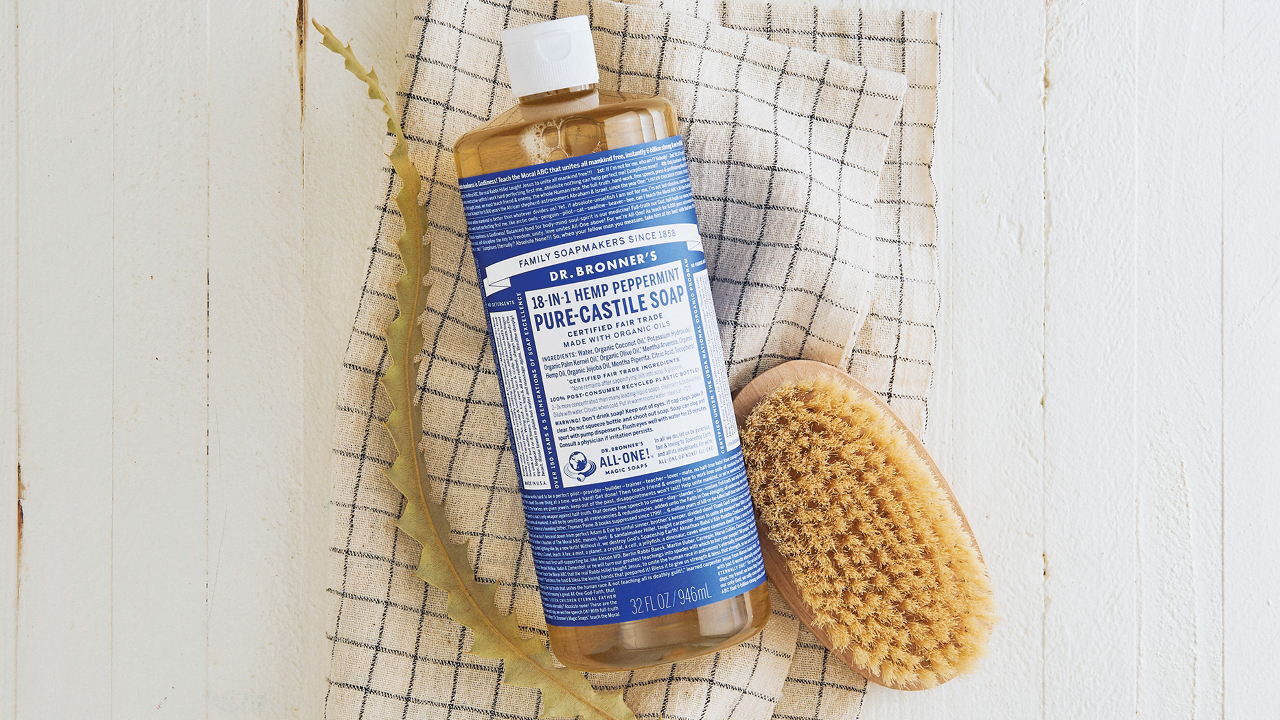
Update May 2022 —I’ve added a few uses to both the Sal Suds and Castile Soap Cheat Sheets. Plus: All four Cheat Sheets are now available in Spanish! (See the side bar to download or print.)
Dilute! Dilute! OK!* But how much? Here is a quick reference. None of this is a hard and fast rule. If your stuff is really dirty or your water is really hard, then you may want to use more than the recommended amount. However, this should get you started. You’ll notice that for some applications, I recommend pre-diluting the Dr. Bronner’s Liquid Castile Soap—combining the soap with water in a container. For other applications, the soap is diluted by the water present in the situation. It’s a matter of personal preference. Keep in mind that if you predilute, you are also diluting the preservation system (tocopherols – vitamin E), so the shelf life drops. Use within a couple weeks. And yes, there are 18+ uses here.
* Long time Dr. Bronner’s users will remember this expression from the old labels.
Body Uses
Face: 2-3 drops on wet hands, applied to wet face.
Body: One small squirt on wet hands or washcloth, applied to a wet body.
Foaming Pump Dispenser: Dilution of one part soap to 3 parts water.
Wipe-Off Castile Body Wash Spray: Use when running water isn’t an option due to illness, large cast or bandage, or when hiking, camping, etc. Combine 1 ½ tsp. (7.5 mL) soap and 1 c. (240 mL) room temperature water in a spray bottle. Spray body wash lightly on skin, and wipe with a wet (not dripping) cloth. Dry skin.
Makeup Removal: Wet face and lather several drops of soap into hands. Massage into skin. Rinse.
Hair: A couple drops for close-cropped hair or up to ½ Tbsp. (7.5 mL) for long hair, either worked directly into very wet hair or pre-diluted in a cup of water. Follow with a capful of Dr. Bronner’s Citrus Organic Hair Rinse diluted in one cup (240 mL) of water or dilute apple cider vinegar in half with water.
Bath: Completely depends upon water amount, but approximately 2 Tbsp. (30 mL) soap in an average sized tub. (Doesn’t bubble, but still cleans.)
Shaving: Face—10 drops; Underarms—3 drops; Legs—½ tsp (2.5 mL); Work to a lather in wet hands, apply to area.
Teeth: 1 drop on a toothbrush. (Yes, it tastes like soap.)
Oral Appliances: Removable retainers, nightguards, etc. & dentures: Wet device. Add 1-2 drops of soap to a soft toothbrush. Brush gently, then rinse.
Foot Bath: ½ Tbsp. (7.5 mL) in a small tub of hot water.
Clearing Congestion: 1 Tbsp. (15 mL) Peppermint or Eucalyptus Castile soap in a bowl of steamy hot water. Breathe in mist with a towel draped over the head.
Household Uses
Dishes (Handwashing): Pre-dilute 1:10 with water. Squirt on a scrub brush. Alternatively, add 1-2 Tbsp. (15-30 mL) Castile Soap in a large sink of water. Use a small squirt of soap for one pot, or more if needed. To avoid water spots in hard water conditions, dry dishes by hand.
Laundry: 2–4 Tbsp. (30–60 mL) for HE washers. Add ½ c. (120 mL) vinegar to the rinse cycle. Optional: For whitening/deodorizing, add ¼ c. (60 mL) baking soda to wash cycle. Double these amounts for standard washers.
Handwashing Delicates: 1 capful (1 Tbsp. or 15 mL) Castile Soap in about 1 gallon (4 L) cold water. Swish gently. Let soak 10 minutes. Swish again. Rinse with clean water. Gently press out excess water with a towel. Hang or lay clothing flat to dry.
Mopping (Wood, Laminate, Vinyl, Stone & Tile Flooring): 2 ½ Tbsp (38 mL) of soap in 1 gallon (4 L) of hot water. Dunk mop (microfiber, preferably) and wring thoroughly. On wood and laminate, avoid excess water and mop up wet areas.
For smaller areas, add 2 tsp. (10 mL) Castile Soap to a quart (1 L) of water in a squirt bottle.
All-Purpose Cleaning Spray: 2 Tbsp. (30 mL) soap in 16 oz. (500 mL) water. Spray and wipe with a damp cloth. Optional: For extra microbial punch, add ¼ tsp. (1.25 mL) tea tree essential oil. Use on any surface that is safe in contact with water-stone countertops & tile; wood (painted or sealed, not waxed); plastic toys and such; stainless steel; sinks & toilets; and more!
Windows: ½ Tbsp. (7.5 mL) soap in 16 oz. (500 mL) water. Spray and squeegee. Follow up with pure club soda, or half vinegar/ half water and squeegee.
Toilet: Predilute 1:4 with water in a squirt bottle. Add ¼ tsp. (1.25 mL) tea tree oil. For best results, empty toilet. Spray or squirt 2-3 drops of Castile Soap directly on toilet brush. Sprinkle baking soda on the brush, scrub bowl, let sit 10 minutes, turn water on, flush.
Other Uses for Liquid Castile Soap
Fruit & Veggie Wash: 1 dash (approx. ¼ tsp.) in a bowl of water. Dunk produce and swish. Then rinse in clear water.
Dog Washing: Wet dog thoroughly. Massage in enough soap to create a good lather. (Amount varies based on size, hair type, and overall dirtiness.) Really massage it in down to the skin. Your dog will thank you for it. Rinse thoroughly.*
Cleaning Makeup Brushes: Wet the make-up brushes in water. Add 1-2 drops soap to the bristles. Massage in gently for 10+ seconds, then rinse. Repeat as needed until water runs clear.
Plant Spray for Bugs: 1 Tbsp. (15 mL) in a quart (1 L) of water. Optional: Add ½ tsp. (1.25 mL) cayenne pepper or cinnamon. Spray plants twice daily in the cool of the day until infestation clears.
Ant Spray (Not on plants): ¼ c. (60 mL) Tea Tree Castile Soap in a quart (1 L) of water. (This concentration will burn plants.)
I’ve tried to keep this short and sweet. If you have any questions, please ask away!
Not sure when to use Sal Suds or when to use Castile Soap? Head over to my blog post, Sal Suds or Castile Soap—Which to Use?
If you’re interested in using the Castile Bar Soap for house cleaning, check out my Bar Soap Dilutions Cheat Sheet.
Further reading
- Sal Suds Dilution Cheat Sheet
- Sal Suds or Castile Soap – Which to Use?
- GIY All-Purpose Cleaning Spray
- Bar Soap Dilutions Cheat Sheet
*Avoid using the Tea Tree scent to wash your pets, as tea tree oil can be toxic to them.
This dilution and many more are in my book, Soap & Soul: A Practical Guide to Minding Your Home, Your Body, and Your Spirit with Dr. Bronner’s Magic Soaps, available now in hardback on DrBronner.com or at your favorite bookseller, and as an eBook and audiobook (read by me!) from wherever you download or listen.





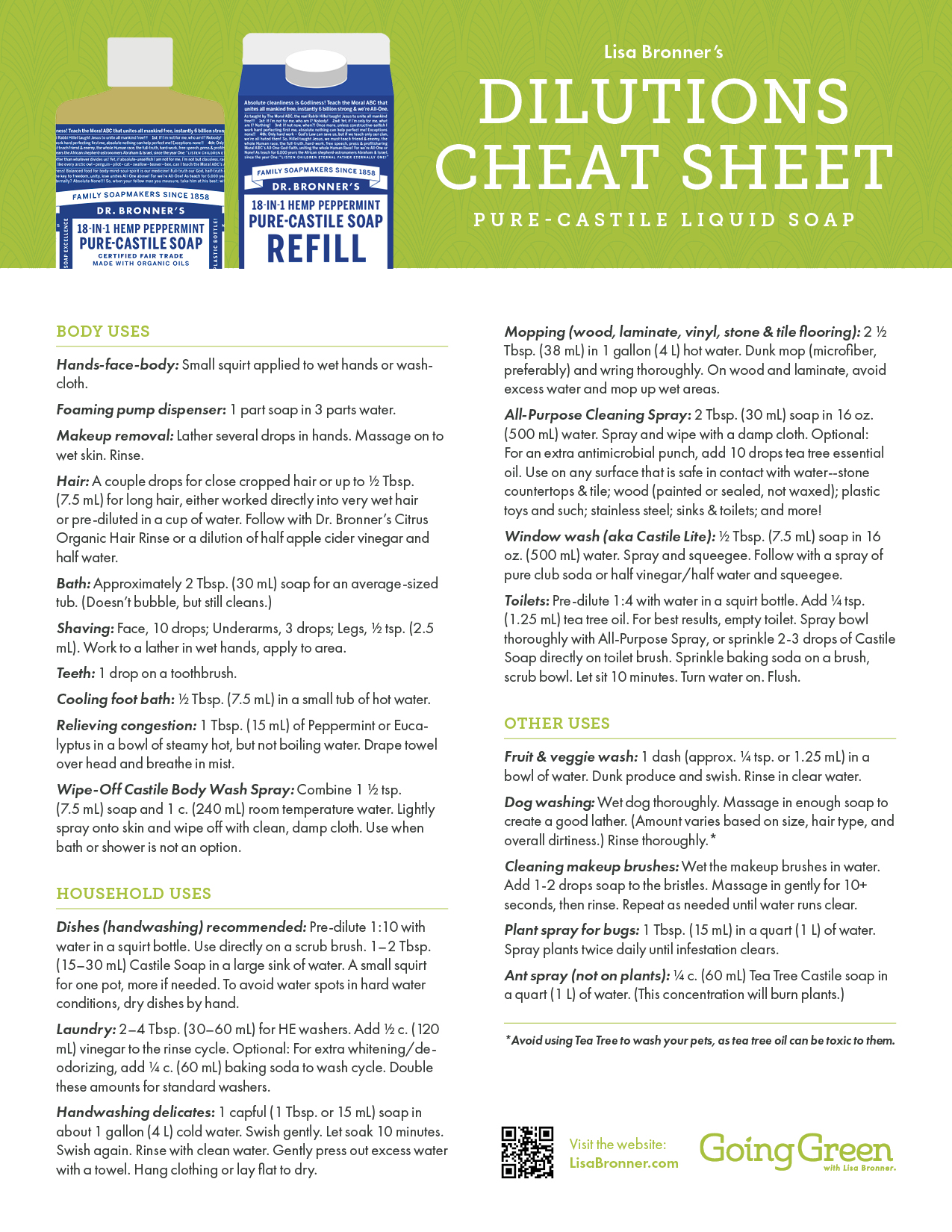
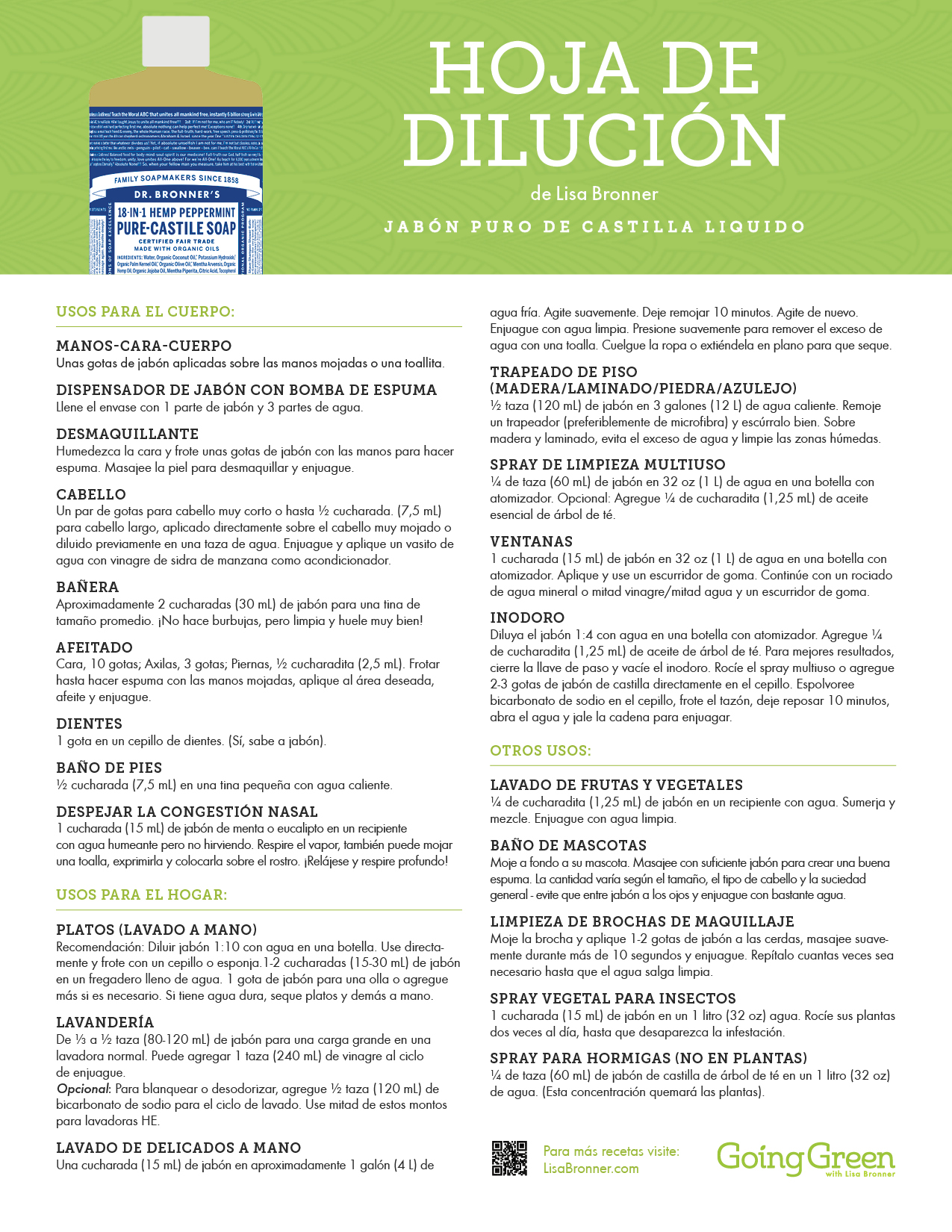
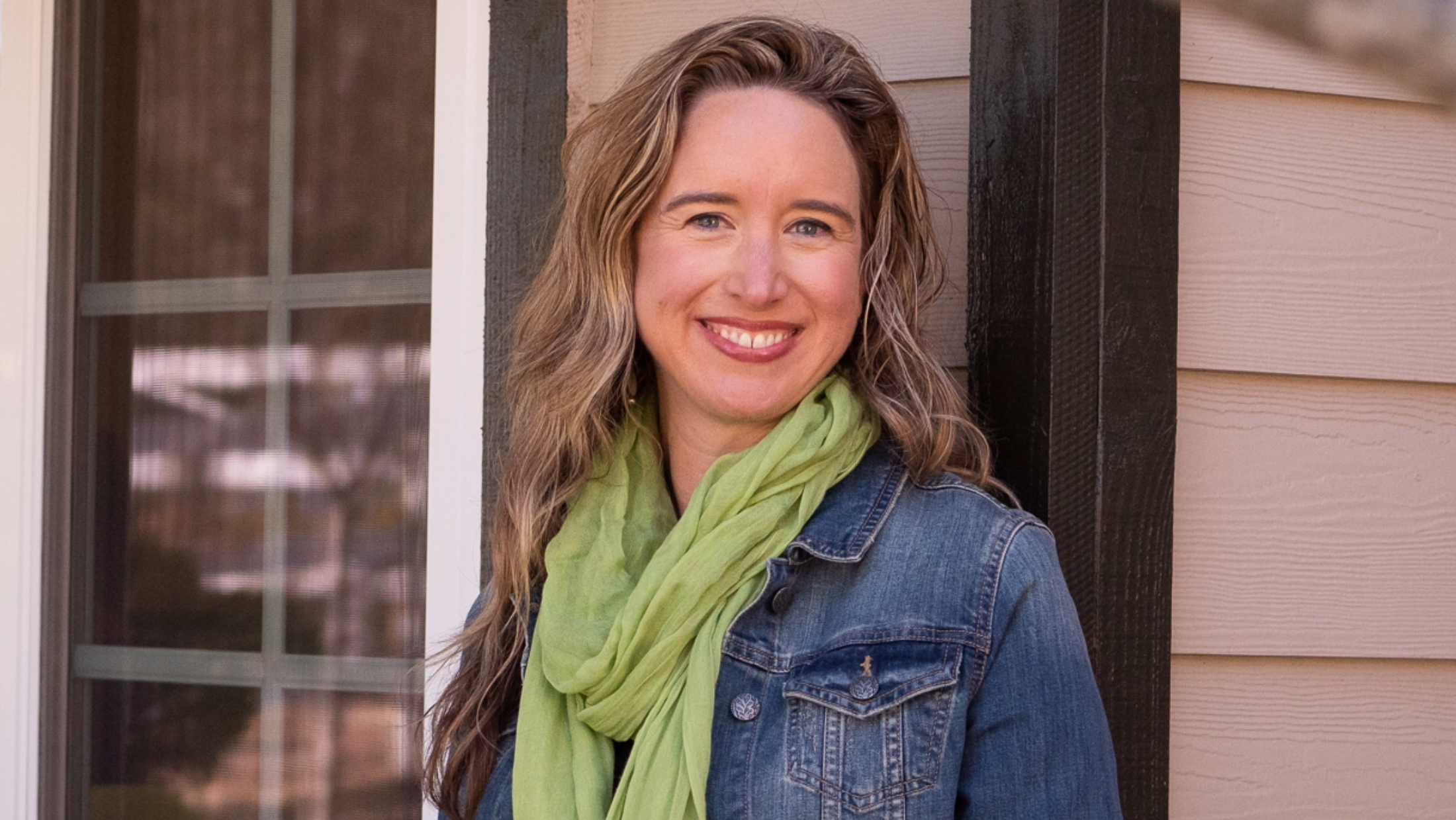

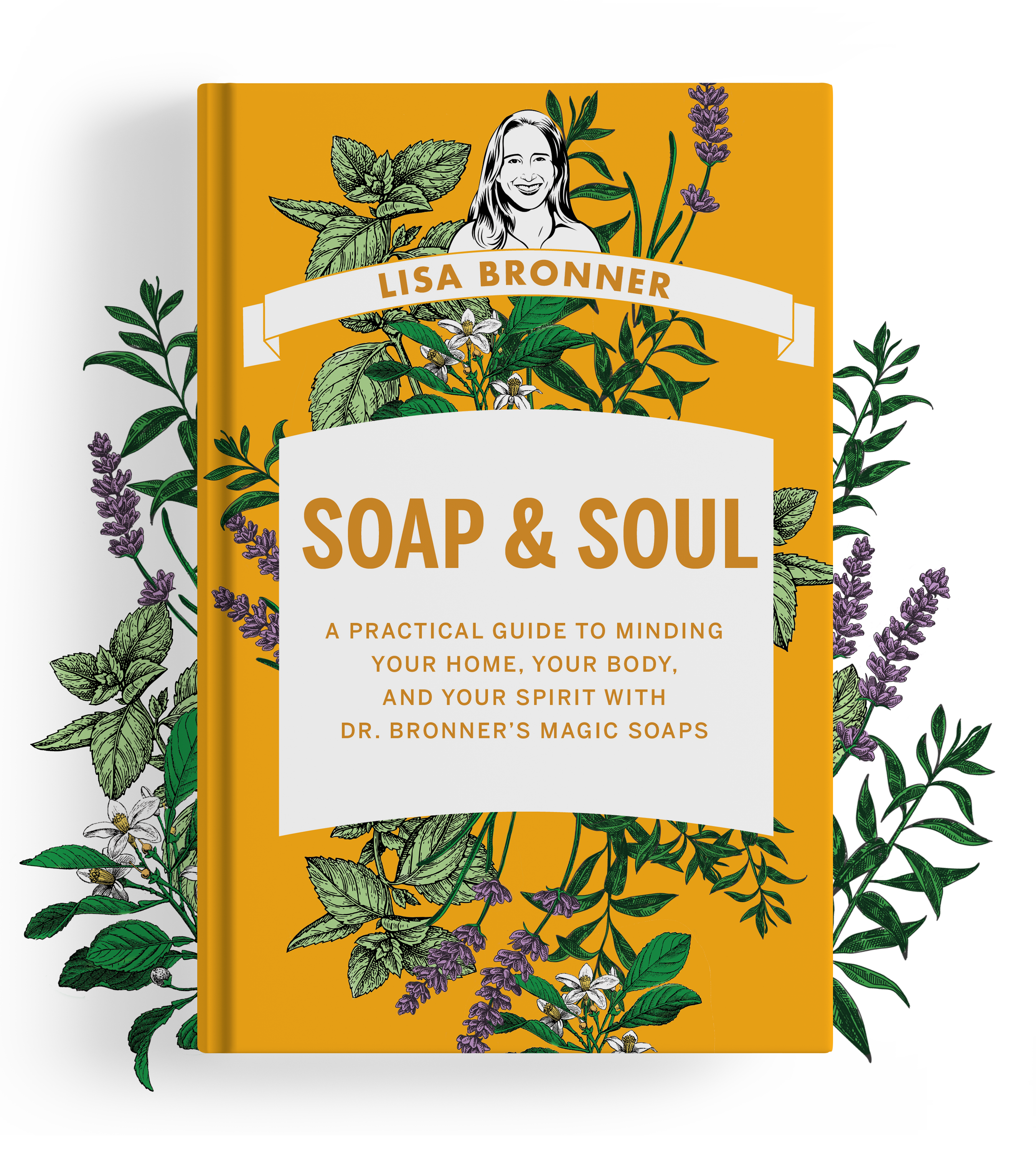
Hi Lisa. I’m planning to used foaming dispensers of diluted castile soap in all my bathroom sinks. However, one of the bathrooms is rarely used, so I’m afraid that the bottle of soap will sit there for a couple of months before being used up. Is there any way to make the diluted soap last longer without going bad? For example, what if I used distilled water or boiled the water before mixing it with the soap?
I want to make a hand soap out of the 32 oz bottle of Dr. Bronner liquid soap. The 32 oz bottle is rather large and it might be awhile before I use it up. Will the undiluted Dr. Bronner keep for awhile or must I use it within a particular time frame?
Can you use the Shikakai to make the foaming soap like you would with the normal castile soaps?
I also make foaming soap with Dr. Bronner’s. (Tea Tree & Lavender mix is my favorite.) I use 1 part soap to 5 parts of water, but water in the Portland, Oregon area is notoriously soft. I am familiar with Southern California water and I know it’s on the hard side, so of course more soap would be necessary.
Can you intermix castile soap scents to achieve a mixed fragrance? Or will that affect the consistency of the product?
Can I use the soap to scrub my pool tile?
Hi Lisa, I want to dilute castille soap with aloe for my shampoo. Do I need to add an extra preservative? If so, what would be best and would it change the shelf life?
Kirk’s Castile Soap is cheaper: “I was able to purcahse 3-4oz soap bars for $4 at my local grocery store, compared to $5 for ONE-6oz bar of Dr. Bronner’s.”
I’m interested in using the castile soap to make a home made body wash…diluting with water and adding in some thickener. My question is…with the addition of water do I need to add a preservative to prevent bacteria growth or does the castile have preservatives in it?
Thank you Lisa for putting together this comprehensive tip sheet. I have so far tackled the toilet/sink with just the diluted Dr. Bronner soap and am very impressed by the result. Being pregnant is a strong motivation for me to finally phase out dangerous chemicals from the house. I will be trying out more applications from the tip sheet!
Lisa, for laundry use, can I skip the vinegar or put it all together with the soap at the beginning? Just don’t want to wait to add the vinegar for the rinse. I usually just load the laundry, add detergent, and leave it there till it’s done. Thanks.
Dear Lisa.
You will not believed what I have used for. I have 3 girls with very long hair and the youngest had lice and spread to the rest, my remedy was to wash their hair with Dr.Bronner Castile soap left a while and rinse with Braggs organic apple cider afterwards I straight their hair with a flat iron to kill any eggs left, and it worked withing 2 days no more lice and did not have to cut their hair.
I love these products have them all for all my needs
sincerely Halls girls
Would just the peppermint liquid soap be enough if I want to clean a really dirty bathroom? I don’t have access to tea tree oil or the tea tree soap.
If yes, what should be the dilution ratio for mopping, given the extra dirtiness of the bathroom?
Thank you very much!
Hi Lisa! I have been using the soaps to make my own cleaning sprays, always adding lavender oil for the disinfectant properties. I have the tea tree soap and am wondering if I can use this without the lavender to make my spray and still have the disinfecting. The peppermint and orange soaps that I’ve used with the oil ends up smelling a little odd. 😉 Thanks for all the great ideas and advice!!
Hi Bethany & Knatali- As you’ve noted, the Dr. Bronner products are not “tear free”. Check out this post on why from a while back: http://lisa.drbronner.com/?p=25. Diluting the soap would not change this situation. Using the washcloth to control the suds, and not using soap on their faces are the key to a safer wash. The soap is a great match for baby’s skin.
All the best,
Lisa
Hi Alfie – Yes, it would still be the case regardless of the external temperature. It’s not a matter of the soap’s getting cold – the problem is that the water content evaporates out of the soap, leaving a semi-solid soap behind. That would probably happen faster in a warm climate, actually. Go with the Dr. B’s Shikakai soaps, or a foaming pump dispenser with a 1:3 or 1:4 ratio.
All the best,
Lisa
Hi Ashlee – Congratulations! Yes, this soap is safe to be used on a newborn. However, it shouldn’t be left on the skin. When my kids were babies, I hadn’t delved into the world of DIY stuff like this, but I haven talked with friends who have newborns. One friend makes this spray: Lavender ‘n’ Tea Tree
1/8 cup olive oil
1 tablespoon lavender castile soap
4 drops tea tree oil
8 drops lavender oil
3 cups water
She sprays it on and then wipes it off with a soft cloth.
All the best,
Lisa
Also just purchased the mild baby castile soap and am testing it out on my family before baby gets here. I mostly purchased it to make baby body wash and for a wipe solution. However, I as well don’t know how to safely dilute for babies. Advice is greatly appreciated!
Hi! I recently purchased the large Baby castille soap and wanted to use it for my toddlers baths. However, it seriously burns his eyes, so I stopped using it. Now that I’ve read this post, will diluting it solve that problem? If so, what ratio should I use for his shampoo and body wash?
Hi there! I’ve read on previous blog posts that pre-diluting Dr Bronner’s in a traditional pump bottle is ill-advised due to the possibility of it hardening. Would that still be the case in a tropical climate of 30’C year-round?
Thanks!
Hi,
I want to use the baby mild soap to make homemade baby wipes. My baby is due in a few weeks and I was wondering if this soap is safe to be used on a newborn?
Thanks!
Hi Tina – Personally, I wouldn’t use SAl Suds in the dishwasher. It produces way too many bubbles. And to be even less helpful, I don’t have a good recommendation for what to use. When I come up with something, I will definitely let you know. I add baking soda with the Sal Suds in the laundry to my whites and any particularly dirty load. I also put 1/2 c. of white vinegar in the rinse for extra whitening power.
All the best,
Lisa
Hi Lisa,
Can I use Sal Suds in my dishwasher? I’m using it to wash my clothes. Do you recommend adding baking soda along with the Sal Suds? Thank you so much!
Hi Tracy – You aren’t kidding about hard water in AZ. I thought I knew what hard water was, and then we stayed in Kingman during a cross-country road trip. Wowza. Honestly, because the castile soap is going to react so strongly with the minerals in the water, I wouldn’t pre-dilute it. Keep an 8 oz. bottle or so in the shower, and use about one teaspoon on a wet washcloth to wash your body.
All the best,
Lisa
Lisa:
I am severely chemically sensitive and finding even pure glycerine liquid soap too harsh. Purchased unscented liquid Dr Bronner’s to try – is it safe for eyelids/eyelashes?
Hi,
I’m pretty new to Dr. Bronners, so appreciate the post. I have a 5 week old baby and am wondering about using the unscented liquid soap to clean bottles and other things that end up in my bub’s mouth. Would you recommend this? And what dilution ratio would you suggest?
Thanks!
i am wondering why the potassium hydroxide is used to manufacture the bronners casille liquid soap. how do i know that there is really none left after saponifying? it does not seem to be a friendly chemical.
kind regards
Regina
I am diluting to help prevent a liquid soap dispenser from clogging. The 1:4 ratio seems to work well, and I shake afterward for consistency. In another thread you said that dilution reduces the preservative (Vitamin E), so “if the solution smells different, don’t use it.” What would that be like — bacteria, or do you just mean the breaking down of materials?
I hope I can find a dispenser that doesn’t require dilution, because I actually would prefer that. Going to try a foaming dispenser as well.
Hi Lisa!
Awesome guide! Just wondering about baby wipes solution? What is the ratio and do I need to add any other ingredients? Thank you!!
Katie
Hi Lisa,
I live in AZ (hard water) and I’m curious what is a good ratio for making body wash? I purchase the gallon size and would like to have a smaller bottle in the shower.
Thanks,
Tracy
Hello Lisa!
Thanks for answering my questions!
Hi Cathy – The pure Castile soap and the Shikakai pump soap are built on the same soap base. Think of the castile soap as the original, and the Shikakai pump soaps as the original plus. The difference is two fold: the original castile does not work safely in a traditional pump, and Dr. Bronner’s strongly discourages people from putting it in them. It inevitably solidifies in the pump apparatus and before it clogs completely, it forces the soap out in unexpected directions, even possibly up into the face of the unsuspecting hand washer. So, because people really like their pumps, my brother Mike formulated the Shikakai to work in pumps, and it even comes in a pump. The secod main difference is that the Shikakai extract is additionally moisturizing.
As far as the cleaning powers, since both contain the same soap base, they both clean equally well. Personally, I prefer the pure castile, but that is completely personal preference If you want to use the Castile in a pump, use a foaming pump at a ratio of 1:5 or whatever works for you.
Hope that helps! Let me know if you have further questions.
All the best,
Lisa
I have a few questions for you! 🙂
1. Is there a difference between the classic liquid soap and the organic handsoap? Why is there a separate handsoap/body soap when the classic liquid soap can be used for the same purposes?
2. Does the classic liquid soap have specific ingredients that aids in thorough cleansing of the hands? The reason I am asking is because as a nurse, I want to make sure my hands are germ-free inside the house. I don’t want to bring anything nasty from the hospital into my home. I am hoping this soap can do a good job for that! Please do let me know, thanks in advance!
Hi Stacy – The citric acid in the soap is added only after each batch is tested for pH levels. The citric acid is added to neutralize any sodium or potassium hydroxides leftover from the saponification – or soap making – process. So, the citric acid is fully consumed in this process.
Regarding the glycerin, I have heard thoughts both ways on the presence of glycerin in toothpaste. I haven’t seen a study on it one way or the other, and if anyone knows of one, please send it my way. As far as why glycerin is in the soap, it is also a leftover from the saponification process. Oils are turned into soap by splitting apart the oil molecule with hydroxides. Oil molecules, also called triglycerides, have three fatty acid chains (thus the “tri”) attached to a glycerin backbone. The fatty acids detach from the glycerin and combine with the potassium or sodium and the glycerin is left free-floating. So, that’s why there’s glycerin in the soap. And a lot of chemistry. The glycerin also adds to the soap’s creaminess.
Hi Linda – Thanks for the heads up. Please also take care in putting the castile soap in regular pump dispensers. Even diluted, it can dry inside the pump and cause the solution to shoot out in unexpected directions, even up into the eyes. We’ve seen enough of this that we have also included a caution against traditional pumps on the castile label. The Shikakai soaps, though, work great in regular pumps.
Hi Julie – Fabulous! I am so glad to hear how much a part of your routine Dr. Bronner’s has become.
All the best,
Lisa
I love to use for everything – I clean my house with Sal Suds — but I really like the castile soaps – My favorite is the rose or lavender — It is funny I will try other shampoo occasionally and my hair feels weighed down – and then I go back to Dr Bronners’ soaps – It is my favorite thing to use for home and my dogs my house me !
– I use on my face — I have some baking soda on my face too — It makes your hair feel clean !
Thank you for this information. I have been diluting the unscented castile soap into a regular (plastic) pump dispenser, for hand washing, and have noticed it starts to smell bad and becomes cloudy. And always wondered why. Now I know that the preservative stops working after a couple of weeks. Perhaps this could be printed on the bottle?
Per using it for teeth I wondered about the glycerine and the citric acid in the castile soap. I’ve read that glycerine is not good for teeth as it doesn’t allow them to remineralize because it coats the teeth and that it also overtime it doesn’t allow gums to heal because, again, it coats the gums.
Also is the citric acid safe for teeth?
I do thank you for this list and have printed it up for future referrals.
Hi Hillary – The Sal Suds is more clean rinsing than the castile soap, but other than that, they are very interchangeable. The castile soaps have the variety of fragrances, and can also be used on the body. Their chemical composition differs as well because the Sal Suds is a detergent and the castile is a soap.
Hi Leslie – The Sal Suds is even more concentrated than the castile soap, so you need only half the amount or less when you convert from a castile recipe.
Hi Lou & Stephanie- In my foaming pump dispensers, I use about 1 part soap to 4 parts water. It does depend on your water hardness and how much foam your pump dispenses, but hopefully if you start with this, you can tweak it to your situation.
Hi Dave & Spice Man – Great suggestion! We added a PDF if you click on the link in the last sentence of the post.
Hi Jon & Sean- It does depend on what you’re using it for and how much you squirt out. However, if we’re talking for the body a 1:3 or 1:4 ratio, prediluted, sounds pretty good. Use one or two good squirts on a washcloth for head to toe. This aspect of the soap isn’t an exact science, so 1:4 sounds good, 1:3 sounds good – it all depends on how much you’re using. If you’re getting a good lather, then you have enough.
Hi Shannon – You’re welcome!
Keep the questions coming!
All the best,
Lisa
Lisa,
This is awesome! Thanks for a great resource!
Shannon
Hi, Lisa,
What is the ratio for diluting the soap in a foaming soap dispenser for hand washing?
Thanks for this post! I was just coming to find out how to clean the toilets naturally 🙂
Hi,
Please make a printable copy of this that fits on one page.
Thanks,
S
I like to pre mix a bottle of shower soap. I’m still working on the “recipe”. Do you think it should be about 1/4th bottle Bronners (the rest water)?
Thanks!
Hi Lisa, if I have a 400ml bottle, is it okay for me to put in 100ml of Dr. B’s soap and fill the rest of the bottle with water? Considering 1:3 dilution ratio. Is that going to be too much soap or is it alright?
Thanks.
Perhaps this info could be reformatted and made available in a downloadable format, pretty please?
I like to refill the foaming soap dispenser with Dr. Bronner’s and water, but never the get the proportions of soap/water right. Any suggestions?
I use sal suds for cleaning. do the amounts change any?
Hi Lisa
i’m sorry you’ve probably answered this a million times, but I’m fairly new to Dr Bronners.
I’m using the sal suds for my everyday cleaning and washing. is their a big difference between using the sal suds as opposed to the soap
Thanks
What a useful post – will go right on my fridge! Tks!
Hi Annie – At the moment, I don’t know of any other uses for the hair rinse, but I am going to ask the Dr. Bronner’s staff.
Hi Tom – Excellent idea. I will do that next.
Thanks, Maureen!
All the best,
Lisa
I love this. Please make one for sal suds too!
Hi Lisa, what about the hair rinse. Are there any other uses than rinsing the hair? Annie